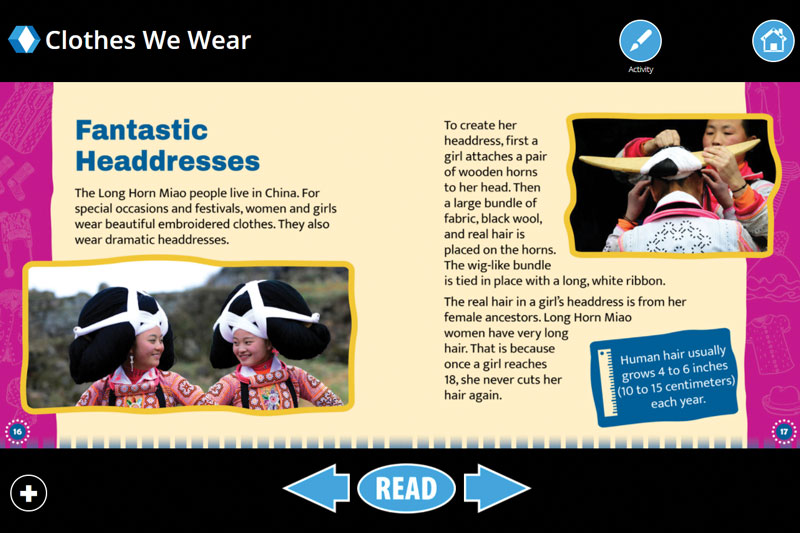Weigl’s Lightbox | Reference Database Review
Bringing nonfiction print and ebooks together with related interactive multimedia, Lightbox is a digital platform for reading or research across all grade levels and multiple content areas.

URL openlightbox.com
Grade Level K Up
Cost Lightbox is sold with a per-school, unlimited user license. Three modules are available: one each for content aimed at kindergarten through second grade, grades three to five, or grades six to 12 as an annual subscription at $999, any two for $1,500, or all three for $1,750. Multischool discounts are available. Individual titles may be purchased along with a print book. The library-bound books retail for about $25, or $40 when combined with the digital resources.
Content Bringing nonfiction print and ebooks together with related interactive multimedia, Lightbox is a digital platform for reading or research across all grade levels and multiple content areas.
The landing page includes a scrolling menu, displaying rows of book cover images. Above it is a preview window with a looping, 10-second video segment from one of the digital books (the last one that users have hovered over), as well as the title, a brief summary, the name of the series (“About Our World,” “Great American Holidays”), and the reading and interest levels.
There are currently around 1,000 titles, the majority of which are aimed at a kindergarten through fifth grade audience. A filtered search for Spanish-language content brings up 47 titles, none of them at the high school level.
Though some of the controls on the site take getting used to, they are generally effective. To increase text size, for instance, users click the plus/minus icon but must click a second time within the text in order to zoom to a preset level.
Books open in a new tab, and page thumbnails are arranged in a grid. The colorful pages are generously illustrated, which will appeal to reluctant readers. Hovering over the icons for “Lightbox standard features,” such as audio or video, highlights the pages that contain those elements. Clicking a thumbnail opens the page. If video is present, a pulsing “play” icon appears in the center.
Many pages contain audio features as read-alouds for text. In books for older students, the narrator sounds automated and sometimes the cadence is awkward.
Other features include activities, slideshows, transparencies (annotations and overlays for illustrations that may be added or removed by clicking), quizzes, maps (interactive Google maps that open in a pop-up window), and external web links.
The linked websites are relevant, and all checked links were active. Some linked sites are personal pages and might need to be evaluated individually. The book Fractions, tagged at the second grade reading level, links to an informative blog maintained by an Australian early childhood teacher but is not associated with any institution.
Lightbox is promoted as being compatible with tablets and “large screen smartphones.” On a standard size phone, text piles up in layers, making reading difficult, and the index is largely impractical. On a two-year-old iPad, running Chrome, the site appears as it does on a laptop screen or monitor, and navigation and video play are mostly normal except for mouse-dependent features.
Student and teacher resources In addition to a standard search box, the main index page includes buttons to filter content by age level and subject area (science, social studies, or language arts), as well as Spanish language.
Activities are of mixed utility. Many of the books offer vibrant word searches, mazes, and “spot the difference” photo displays. Those observed are mostly in PDF format with fillable name and date boxes, but would have to be printed to be completed and turned in. This is less helpful in a distance learning environment. Interactive key word quizzes don’t indicate when a student gets one wrong until the end, and mistakes can’t be observed and corrected without taking the quiz again.
Some quizzes are interactive PDFs and could be filled out electronically and emailed, but there is no facility for a teacher to monitor or track the activity.
A “curriculum” button opens a new tab detailing relevant standards, such as Common Core or those from the National Council for Social Studies or Texas Essential Knowledge and Skills for Science. However, the search function does not include these curriculum standards.
According to marketing materials, Lightbox is compatible with learning management systems, including Google Classroom, Canvas, Blackboard, and Schoology, as well as integrated library systems such as Follett Destiny and MackinVIA.
A link to “copyright & acknowledgment,” under the standard features, launches a pop-up window detailing the author, copyright statement, and sourcing information for videos. While books generally include an index and glossary, they lack any sourcing information, other than for videos, or suggestions for further reading.
No citations or citation generators are provided.
Tracking student usage requires submitting a request to the vendor.
Verdict Competitively priced and rich with features, Lightbox effectively curates a variety of related resources, along with reading supports for students and curriculum and assessment tools for teachers. Despite some minor detractions, Lightbox is recommended for all school levels and is an especially strong choice for elementary grades.
Bob Hassett, Luther Jackson M.S., Falls Church, VA
RELATED
The job outlook in 2030: Librarians will be in demand
The job outlook in 2030: Librarians will be in demand
ALREADY A SUBSCRIBER? LOG IN
We are currently offering this content for free. Sign up now to activate your personal profile, where you can save articles for future viewing






Add Comment :-
Be the first reader to comment.
Comment Policy:
Comment should not be empty !!!